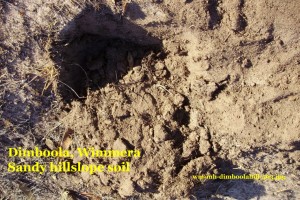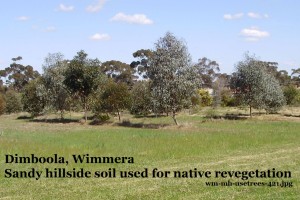From farmland soil to native habitat
 Description:
Description:  Shallow and sandy with a lime clay base
Shallow and sandy with a lime clay base
Location: 4 acres in a hilly paddock on the edge of town.
Values for this soil:
– It responds to rain quite readily
– Grows native trees such as Mallee Gums, Golddust Wattles, and Bulokes to provide habitat for native birds
 – Aesthetics – lovely to look at on the edge of town
– Aesthetics – lovely to look at on the edge of town
– Longterm vision to return use of soil from cleared farmland to treed native habitat
Challenges- managements for reclaiming this soil from supporting cleared broad-acre farmland to regrowing native vegetation:
– Hilly – To prevent water erosion the land is contour ploughed into ridges
– Dry years – Trees planted 7 ½ years ago. Since then, only 2 years have had average rain (450mm/pa); rest have been drought years. Long preparation of soils, has yielded a good survival rate.
– Clay base – Gypsum was spread on the hill 15 years ago, then sewn to oats, followed by barley
– Erosion – Native grasses grow over the ground for protection against wind erosion in summer. The area is mown in Winter and Spring to reduce the fire hazard in Summer when these grasses dry off.
For more
– about the Wimmera’s sandy soils visit the VRO webpage
– Wimmera-Mallee sandy soils which, though drifting, still have their native plants visit the Pine Plains and Banyan Soil Selfies.
– Soil is also supporting a revegetation project in the M’fango Island Soil Selfies from Kenya on a much bigger slope
Credits: Marg Hunter, of Dimboola, gives permission for her photos and information to be used under a (cc) license 2015; Editing and page created by Jeanie Clark, enviroed4all®, Warracknabeal, under a (cc) licence 2015
Return to Soil Selfies Collection by places to Wimmera-Mallee
page setup 6 April 2015, updated 9 January 2016
